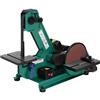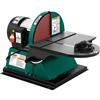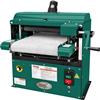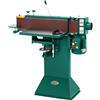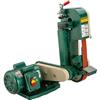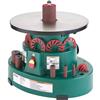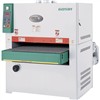Sanders
Product Results
Summary for Sanders
Sanders: Precision Tools for Every Finishing Task
Whether you're a DIY enthusiast, working in a professional shop, or an industrial business owner, finding the right sander is key to achieving a flawless finish. Our extensive selection of sanders covers everything from heavy-duty industrial models to versatile combination units, ensuring you have the perfect tool for preparing surfaces, smoothing edges, and removing material from both wood and metal. Explore a full range of sanding machines, including the specialized categories listed above: Combination Belt & Disc Sanders, Disc Sanders, Drum Sanders, Edge Sanders, Sander/Grinders, and Wide-Belt Sanders.
Frequently Asked Questions
What are the main types of sanders and their primary uses?
Our sander categories are designed to meet specific material removal and finishing needs:
- Combination Belt & Disc Sanders: Versatile, space-saving machines popular in woodworking shops. They offer the aggressive material removal of a belt sander combined with the fine-finishing capabilities of a disc sander.
- Disc Sanders: Excellent for shaping curves, smoothing edges, and removing burrs. They are widely used in both metalworking and woodworking for fast, precise stock removal.
- Drum Sanders: Primarily used in woodworking to handle large pieces of stock, such as cabinet doors or tabletops, offering a high-quality finish and consistent thickness across the entire surface.
- Edge Sanders: Specialized for finishing the vertical edges of wide stock. These are essential in professional woodworking and millwork for creating clean, square, or radiused edges.
- Sander/Grinders: These are powerful, heavy-duty machines primarily for metalworking. They pair aggressive belts with a platen to handle serious material removal, weld smoothing, and deburring steel, aluminum, and other hard metals.
How do I choose between a metalworking and woodworking sander?
While some machines, like combination belt and disc sanders, can be used for both with the correct abrasive, most high-volume applications require dedicated machines:
- Woodworking Sanders: These often prioritize dust collection, use a finer range of abrasives, and are designed to handle organic materials like softwoods, hardwoods, and composites. Drum and Edge Sanders are common dedicated woodworking tools.
- Metalworking Sanders: These machines are typically built with more durable components, higher power output, and often feature coolant systems to manage the heat generated when grinding steel, aluminum, or other metals. They are designed for aggressive material removal, weld smoothing, and deburring. Industrial belt grinders and large disc sanders are common in this category.
What are the key features to look for when buying a sander?
Key features will depend on your intended use (DIY, Professional, or Industrial):
- Motor Horsepower (HP): Higher HP is essential for commercial or industrial use, especially when sanding large or hard materials like metal or dense hardwoods.
- Sanding Surface Size: Larger belt sizes (e.g., 6"x48") or disc diameters (12", 16") allow you to handle bigger stock and complete projects faster.
- Dust/Chip Collection: Essential for operator safety and machine longevity. Look for high-efficiency dust ports or enclosed systems, especially for woodworking.
- Table Tilt: A tilting table (e.g., 0° to 45°) allows for bevel sanding and handling angled stock, increasing the versatility of the machine.
We are experiencing {{ network.message }}
We're sorry, we couldn't find any results{{ !keywords ? '...' : '' }}
for '{{ searchWithin }}'
{{ searchWithin ? ' within' : ' for' }}
'{{ keywords }}'
Did You Mean?
Summary for Sanders
Sanders: Precision Tools for Every Finishing Task
Whether you're a DIY enthusiast, working in a professional shop, or an industrial business owner, finding the right sander is key to achieving a flawless finish. Our extensive selection of sanders covers everything from heavy-duty industrial models to versatile combination units, ensuring you have the perfect tool for preparing surfaces, smoothing edges, and removing material from both wood and metal. Explore a full range of sanding machines, including the specialized categories listed above: Combination Belt & Disc Sanders, Disc Sanders, Drum Sanders, Edge Sanders, Sander/Grinders, and Wide-Belt Sanders.
Frequently Asked Questions
What are the main types of sanders and their primary uses?
Our sander categories are designed to meet specific material removal and finishing needs:
- Combination Belt & Disc Sanders: Versatile, space-saving machines popular in woodworking shops. They offer the aggressive material removal of a belt sander combined with the fine-finishing capabilities of a disc sander.
- Disc Sanders: Excellent for shaping curves, smoothing edges, and removing burrs. They are widely used in both metalworking and woodworking for fast, precise stock removal.
- Drum Sanders: Primarily used in woodworking to handle large pieces of stock, such as cabinet doors or tabletops, offering a high-quality finish and consistent thickness across the entire surface.
- Edge Sanders: Specialized for finishing the vertical edges of wide stock. These are essential in professional woodworking and millwork for creating clean, square, or radiused edges.
- Sander/Grinders: These are powerful, heavy-duty machines primarily for metalworking. They pair aggressive belts with a platen to handle serious material removal, weld smoothing, and deburring steel, aluminum, and other hard metals.
How do I choose between a metalworking and woodworking sander?
While some machines, like combination belt and disc sanders, can be used for both with the correct abrasive, most high-volume applications require dedicated machines:
- Woodworking Sanders: These often prioritize dust collection, use a finer range of abrasives, and are designed to handle organic materials like softwoods, hardwoods, and composites. Drum and Edge Sanders are common dedicated woodworking tools.
- Metalworking Sanders: These machines are typically built with more durable components, higher power output, and often feature coolant systems to manage the heat generated when grinding steel, aluminum, or other metals. They are designed for aggressive material removal, weld smoothing, and deburring. Industrial belt grinders and large disc sanders are common in this category.
What are the key features to look for when buying a sander?
Key features will depend on your intended use (DIY, Professional, or Industrial):
- Motor Horsepower (HP): Higher HP is essential for commercial or industrial use, especially when sanding large or hard materials like metal or dense hardwoods.
- Sanding Surface Size: Larger belt sizes (e.g., 6"x48") or disc diameters (12", 16") allow you to handle bigger stock and complete projects faster.
- Dust/Chip Collection: Essential for operator safety and machine longevity. Look for high-efficiency dust ports or enclosed systems, especially for woodworking.
- Table Tilt: A tilting table (e.g., 0° to 45°) allows for bevel sanding and handling angled stock, increasing the versatility of the machine.
Shop By Category
- Abrasives & Sanding
- Adhesives
- Air Accessories
- Air Compressors
- Automotive Equipment
- Woodworking Bandsaws
- Contractor, Home & Shop
- Cutlery
- Cutting Tools
- Drill Presses
- Drilling & Boring
- Dust Collection Accessories


